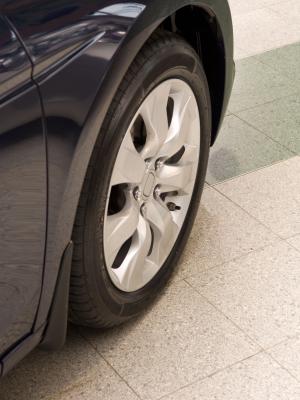
Vehicle camber plates, also called caster-camber plates, consist of a mechanical plate of manufactured steel with slotted adjustment holes that can set an individual vehicle tire at a negative or positive angle. Changing the angle of the tire directly affects the suspension and the turning or handling characteristics of the vehicle. Camber plates are made for any vehicle type and suspension that has the McPherson or coil-over shock design, for front or rear installation. A vehicle owner should know what a camber plate is and how it functions before installing an aftermarket variety on his vehicle.
Camber angle is defined by the tilt or angle of the tire to the inside or outside as viewed from the front of the vehicle. Tires that lean outward, away from the car, have positive camber. Tires that lean inward, toward the engine, have negative camber. A tire that wears treads on the inside has too much negative camber angle, while a tire that wears on the outside tread has too much positive camber. Camber adjustment is made primarily on the front wheels, but some vehicles have camber settings for the rear wheels as well.
Different camber angles determine the handling characteristics of vehicles. Manufacturers can set their vehicles for slight positive, negative or neutral positions. Slightly more negative camber assists a vehicle in making easier turns and can be used with heavier negative camber adjustments in track or autocross applications. A slight positive adjustment can aid in turning, by easing up the feel of the turning response.
Understeer results when tires suffer a loss of traction while performing a turn. This condition causes the vehicle to slide or drift to the outside of the corner. Increasing the negative camber on the front wheels and reducing it on the rear wheels remedies this condition. Oversteer results from the rear wheels losing traction and slipping away to the outside of the turn. Reducing negative camber on the front wheels and increasing negative camber on the rear ones corrects this condition. The camber plate makes these adjustments possible.
The lower control arm must be supported by a jack to relieve the coil-over spring tension. The top strut nut is removed, then the stock camber plate is disconnected, usually by removing three or four bolts, depending upon the model of the vehicle. Once the coil over is pulled down, the new camber plate is fitted to the underside of the coil tower, allowing the mounting studs to protrude up. Spacers and bushings, provided in the kit, are added to adjust for the correct ride height.
The camber plate has adjustable slots and bolts with a hex or Allen head design. Some bolts have threaded cams on certain models and can turn when wrench force is applied in either direction, positive or negative. Marking lines on the plate designate negative numbers, a "0" position and a positive position. Turning a wrench on the bolts either way achieves the preferred setting, usually ranging from 1 to 3 degrees of positive or negative in the opposite direction. The bolts are tightened according to proper torque specifications.